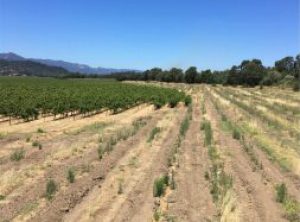
Reach 14 prior to restoration efforts
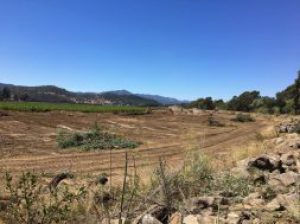
Construction underway to expand the banks of the Napa River and provide new habitat for fish, birds and wildlife.
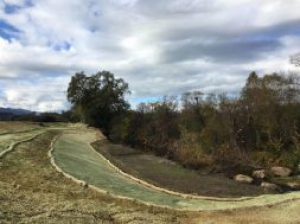
Restored river bank along Reach 14
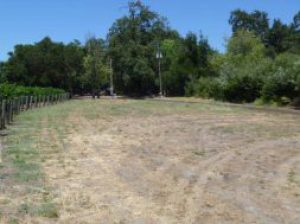
Reach 9 before restoration
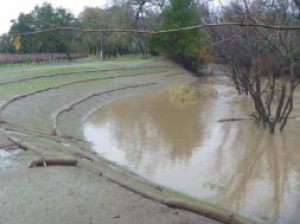
Reach 9 after restoration. Water slows down with expanded area, eliminating incision.
Rutherford Restored
- This project alone achieved more than 80 percent of the mandated TMDL reduction target for the Napa River watershed due to channel incision and bank erosion.
- A continuous 4.5-mile river restoration engaging all 30 landowners across 41 parcels.
- Includes a 20-year self-assessment to fund the project and provide for ongoing monitoring and maintenance.
- 31 acres of vineyard land valued at $9 million were rededicated and revegetated to native riparian habitat.
- More than 2.5 miles of the channel were widened.
- Over 140 in-stream habitat structures were installed to help salmon and trout rebound.
- 5 beaver dams have popped up where beavers haven’t been seen in decades and Swainson’s hawk, normally found in estuaries, have nested on the Reach.
Davie Piña described going before the Coastal Conservancy to request funding: “When we told them we had self-funded the restoration plan, had every single landowner onboard, a partnership with the Napa Resource Conservation District and the County and more than half of the $20 million raised in matching funds, they were floored. People told us it might take 20 years to break ground. We did it in seven.”
The plan was built from the inside out, with landowners like John Williams of Frog’s Leap, Piña and other Rutherford Dust Society leaders building relationships and trust with all the landowners.
In the late 1990s, berm and levee wars were getting litigious and landowners knew building the river banks higher were just ‘staying away from the river.’ Williams recalled looking at breached berms and eroding and collapsed banks, thinking, “If we tackled these different problems together we might have a better chance.”
The Napa Resource Conservation District (RCD) came to the Rutherford Dust Society and proposed a partnership. Many landowners needed to make expensive and time-consuming repairs. By collaborating, they could see benefits, like getting grants and sharing costs. Initially, each landowner contributed based on the length of their river frontage to privately fund a restoration engineering study. Once complete, a public-private partnership with the RCD was formed, called Rutherford Dust Restoration Team (RDRT), and began restoring and managing the Napa River from Rutherford to Oak Knoll.
The idea was to restore a whole reach, not just one spot where you have a problem.
- Davie Piña, Piña Vineyard Management
It’s such a beautiful sight with new terraced banks, and with beaver, salmon and steelhead coming back. It just goes to show that in this age of great skepticism about our political institutions and polarized views about the environment, a group of diverse individuals can find common ground and work constructively with government to build a sustainable river for our future.
- John Williams, Frog’s Leap Winery
Rutherford Reach wineries certified Napa Green Land and/or Napa Green Winery:
- Frog’s Leap (NGL)
- Honig (NGL & NGW)
- Round Pond (NGL)
- Sequoia Grove (NGW)
- Cakebread (NGL & NGW)
- Peju (NGW)
- St. Supery (NGL & NGW)
- Swanson (NGL)
Read the Series:
1
Partnerships Help Restore the Napa River | Restoration of the Napa River is a testimony to the power of public-private partnerships in revitalizing the health of waterways and riparian lands.
2
Rutherford Restored | The Rutherford Reach restoration project has been lauded for rapid accomplishments achieved through private commitment and public partnership.
3
Oakville to Oak Knoll – Building on the Success of the Rutherford Reach | The 9.5 mile Oakville to Oak Knoll (OVOK) Napa River restoration project flows immediately south of the Rutherford Reach restoration.
4
Napa River Restoration Part II: Along the Upper Napa River | The California Land Stewardship Institute (CLSI) is working with landowners on a restoration plan for a 5.3 mile stretch of the upper Napa River just downstream from Calistoga.
I've been at this for 30 years and this is the best, most well-thought-out program I've ever seen.
- Yvon Chouinard, Environmentalist and Founder of Patagonia
